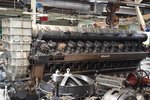Readie
Chief Master Sergeant
When I was on U.S.S. America boilers were never completely cold when at sea. Only a couple minutes were required to bring an idle boiler into service. This sort of thing happened when an aircraft had a flap / slot problem that required a higher landing speed or more wind over the flight deck.
If the USN could find a solution I suspect other nations could also.
There's a difference between 'cold' and 'not up to working pressure' with steam boilers dave.
I had a job on the MV Antonio de Satresqui, which was totally steam driven, winches you name it...fantastic relic to be on.
Cheers
John

